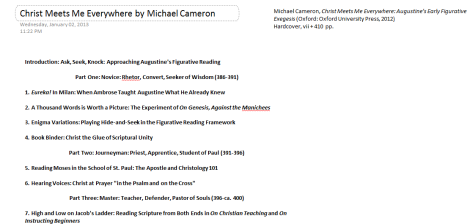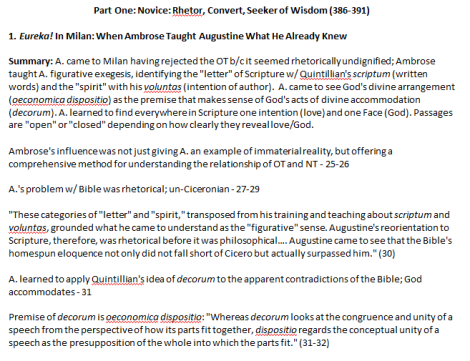The following is from the comprehensive exam at the end of master’s program in theology at Villanova University. I had 3 hours to write a short essay on a question that I did not know beforehand, although I had been working on the general topics most of the semester. Because it was improvised, it is unpolished. But I decided to leave it as it was, except for correcting a few typos.
The question:
How might a retrieval of the thought of Augustine ground the dialogue between Christianity and culture, specifically in engagement with the North American socio-cultural world dominated both by positivism and postmodernism, and in the culturally-informed Christian traditions of East and West?
My answer:
Augustine – The Rationality of Hope
The West is decadent, the East reticent, the future immanent; hope springs eternal. Cultural historian Jacques Barzun titled his saga of the modern West (1500-2000) From Dawn to Decadence. By decadence he meant a loss of confidence in strategies either previously employed or presently at hand to chart a course toward a brighter future. The modern project was full of confidence; it had both a goal and a method. The goal, insofar as it was attained, was ambiguously valuable. After circumnavigating the globe, walking on the moon, and connecting the entire globe in a world wide web, the consensus of the Western world has enshrined as its greatest achievement the HDTV. Ichabod! The glory has departed and with it the hope of significance. Insofar as the goal of modernity was not obtained, the dominant attitude has been iconoclastic reveling at its failure. The aptly titled “play” of postmodernity shakes its head at the hubris of those who made the attempt, any attempt, to overcome fragmentation. So the only remaining goal is to discourage goals. Eros has departed and with it the hope of transcendence.
Eastern Christian culture smarts from its history of domination and its present economic and political unimportance. The dominant impulse is withdrawal and ressentiment. Thicker, thicker, weave the tabernacle curtain, lest the divine presence be seen by outsiders! But write on the outermost face, “Here and nowhere else dwells the God of Abraham, Isaac, and Jacob; of the hierarchs, Symeon, and Palamas.” The hesychast culture offers a stinging critique of Enlightenment modernity, one absolutely true but almost redundant, since every Westerner knows it deep in his bones. On the other hand, the hesychast leap into supra-rationality, in the name of selfless love, is a jump off the speeding train of science and philosophy. The critique of scholasticism in the end turns into a critique of integrating faith and reason, and the mind is finally left behind as a barrier to divinization. Lost is the hope of integrity.
Calling on Augustine to chart a course forward is no simple task. Which thought? He covers so many topics. Better, which Augustine? It sometimes seems impossible to believe that the Augustine of Cassiciacum, so sure in the powers of mind, so confident in the approach of the schools, so optimistic about the possibilities of the moral life should come to regard himself as one of the “little ones,” nursing on Scripture along with his congregants, radically dependent upon the persuasive impulse (suavitas) of the Holy Spirit for any good act. Is there something that unites Augustine in himself and to us? I believe it is his hope.
C. S. Lewis once observed more than argued that if he found in himself desires that no object in this world could satisfy, the best explanation was that he was ultimately intended for another world. This remark is nothing less than an Augustinian insight, a transcendental critique of the restless heart. This desire for happiness in all its permanence and insistence drove Augustine from the early pages of the Cassiciacum dialogues to the densest portions of City of God to demand we recognize the inability of anything merely immanent, merely temporal, to satisfy us. The heart cries out for requiem.
What does it mean to be human? It means to be made oriented toward God (fecisti nos ad te) and destined to possess God (Deum habere). The starting point of an Augustinian retrieval is a firm belief in the existence of a homeland. Yearning for the homeland provides the eros to attempt the journey; glimpses of it furnish the hope that sustains pilgrimage. The epistemological ramifications of this assertion are tremendous. One of Augustine’s earliest works, the dialogue Contra Academicos, is a critique of the skepticism of the New Academy. Augustine’s refutation does not at bottom spring from a list of incorrigible foundations that produce through proper method equally incorrigible conclusions.[1] Thus, for all the similarity between the Augustinian si fallor sum and the Cartesian cogito ergo sum, the intention is wholly dissimilar. Nor is it a retreat from harsh critical thought into the safety of authority or supra-rational experience. Rather, skepticism is dismissed as self-defeating and ultimately as dissatisfying. Epistemology is only a vehicle, and the skeptical rocket will never break escape velocity.
If Augustine is certain of the homeland, he is suspicious of the pilgrims themselves. Human reason, left to itself, is a fragile thing. A person’s thoughts are so influenced by desires, conscious and unconscious, that we easily become an enigma to ourselves. It is unlikely that we can ever pierce below all the veils and layers of our ego to find the real us. Left to ourselves, we are a constant flux of desires. Yet Augustine has latched onto something. He comes to recognize that God is more inward than his most inward self. Interiority pursued sufficiently yields to exteriority; personal identity is maintained in the interplay of relationship, in our tethers to God, each other, our memory, and our future (hope?). To say that we are toward God is not to list an accidental characteristic of man, but a defining characteristic. If this is true of ourselves, how much more so anything that we study? Scientific inquiry, far from an attempt to “save the appearances,” is the concerted effort to penetrate through them to the constitutive relationships that lie beneath.
Modernity, particularly in its positivist form, has no room for relationship as a constitutive element. Its ontology is atomistic; a thing is a self-contained world. Certainly one might apply force to an object, giving it a relation of sorts, but this is a purely external and contingent affair. Modernity cannot grasp the towardness of being and is thus destined to produce reductive analyses. Wholes disappear into an aggregate of parts. Love reduces to psychological states, to brain waves, to biological patterns, to chemical properties, finally to the freewheeling play of atoms.[2]
Postmodern relativism fares little better. In an extreme distention of Heraclitus, all is flux, ergo flux is flux, or rather, flux fluxes. Postmodernity eliminates the subject, but cannot completely remove its echo, and behind every deconstruction whispers a haunting question, “What fluxes, and to where?” An Augustinian inquiry seeks the modus, species, and ordo of each thing. Particularly in terms of ordo, a thing’s system of constitutive relationships, relativity (as in relation-ality) need not imply radical instability or lack of substantiality. If postmodernism has seized the dynamic, whirling character of existence, ordo insists that a dance, no matter how rambunctious, has a rhythm and character that grounds its intelligibility.
An Augustinian alternative to Western modernity or postmodernity lies in hope. If modernity eliminated the need for hope by restricting knowledge to clear vision, and if postmodernity cannot find the strength to hope, Augustine offers this advice: “Dear reader, whenever you are as certain about something as I am go forward with me; whenever you hesitate, seek with me; whenever you discover that you have gone wrong come back to me; or if I have gone wrong, call me back to you. In this way we will travel along the street of love together as we make our way toward him of whom it is said, ‘Seek his face always’” (De trinitate 1.3.5). The certainty of truth, of rest for the restless heart, is an eschatological vision held gingerly in anticipation. The objectivity or realism implied in the identification of the homeland does not preclude fallible maps, wrong turns, or faulty starts. The insistence upon truth is itself a precondition for fallibility, for one can be corrected by a compass only if one admits the existence of North. The adequacy of any philosophical or interdisciplinary project is its promise for getting us home, a judgment that is constantly being made in via as more results come in. An Augustinian rationality might provide the confidence that theology and other disciplines can be related within an intellectual framework without committing theology to any one philosophical framework that would dominate the conversation.
The Eastern Christian tradition presents something of a different challenge. The Orthodox have observed the Western fade from dawn to decadence and chosen to blame Augustine for it. Was it not Augustine’s eudemonism, his insistence that the end of man is to be happy, that led to the West’s narcissism, materialism, and individualism? Was it not his rationalism—his identification of God as idipsum esse (being itself) rather than beyond being and his illegitimate probing into the intertrinitarian relations—that accounts for the hubris of the Enlightenment? Did not his failure to grasp the essence/energies distinction and thus the way of divinization lead him to a legalistic, deterministic view of human nature?
The accusations of the East are all the more serious for being Christian accusations. The nature of God, the purpose of humanity, and the way of salvation are matters of highest moment. If Augustine deviated from the Christian tradition in these areas, it is a serious failure indeed. Yet, it is difficult to answer the charges, largely because they remain vague. Eastern critics of Augustine for the most part have not integrated themselves into the scholarly community, and as such their criticisms often do not interact with the secondary literature and may make idiosyncratic and selective use of the primary literature. Also, a figure in the Eastern tradition is often used as a standard of judgment; if Augustine is to be condemned for not being Gregory Nazianzen or Gregory Palamas, it may be impossible to exonerate him to the satisfaction of Eastern eyes. Thus, we are left with incommensurable judgments.
Yet, perhaps Augustine can throw a challenge to the East, and on some of the very points for which he is criticized. The pursuit of supra-rational divinization can be seen as opting out of the hard work of integrating science, philosophy, and theology. It is appealing insofar as it is anti-elitist, but it leaves the question open of whether there is any unity to our human experience. Can my Christianity truly inform my thinking, or do I simply take comfort in the Jesus prayer as I go about my daily existence? In Augustinian terms, one might wonder whether the East has a tendency to forgo the intellectual journey toward the homeland and content itself with a long-distance phone call, one that encourages a strong foundationalism regarding theology and a relativism regarding everything else. Also, the critique of eudemonism can be seen as an attempt to gain a supra-volitional status, in which a creature’s end no longer falls within that creature’s consideration. Both the alleged rationalism and eudemonism of Augustine could be interpreted rather as the insistence that the pathway home lies in and through the human faculties of reason and will, not by circumventing them. If Augustine offers to the decadent West the hope of a homeland, perhaps he offers to the reticent East the hope of a journey.
[1] Augustine is a foundationalist insofar as he believes there are axiomatic or self-evident truths. But I do not think he is a foundationalist in the sense that he believes one can erect an entire intellectual system on them.
[2] “Play.” Perhaps postmodernity has grasped the logic of modernity better than the moderns ever did.

